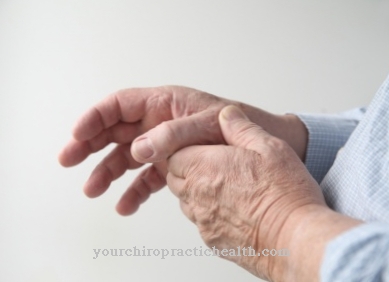The term syncope comes from the Greek, synonyms are for example Circulatory collapse and blackout. Similar symptoms appear in unconsciousness, dizziness and circulatory problems.
What is circulatory collapse?

An acute circulatory collapse, also known as syncope in specialist circles, is a spontaneous and short-lasting loss of consciousness that is reversible. The side effect of a circulatory collapse also consists of the additional loss of so-called postural control.
Syncope is often mistaken for impaired consciousness or neurological seizures. Hypoglycaemia (low blood sugar) does not belong to the group of syncope either.
causes
The cause of syncope is, on the one hand, the result of impaired blood flow affecting the brain. If circulatory collapse occurs more frequently, there may be several underlying causes, which must be clarified by taking an appropriate and detailed anamnesis.
Causes can be, for example, indications of a heart attack, a pacemaker syndrome, cardiac valve defects, psychogenic syncope, visceral reflex syncope, syncope of medicinal causes, cardiac arrhythmia, stenoses affecting cerebral arteries, antiarrhythmics, reflex syncope, atrial myxoma and antihypertensive syncope in the presence of aortic stenosis.
A distinction is made from the purely circulatory-related syncope if there is a loss of consciousness due to other causes, such as: in the case of a seizure, hypoglycemia, narcolepsy, a cerebrally caused or metabolically caused loss of consciousness.
Diseases with this symptom
- Heart attack
- Valvular heart disease
- Diabetic neuropathy
- Cardiac arrhythmias
- Antiarrhythmics
- Cardiomyopathy
- Seizures
- Narcolepsy
- Hypoglycemia
Diagnosis & course
With the listed syncopes, a clinical differential diagnosis is extremely difficult to distinguish from the “real” syncope, since further examinations are required for a fundamental diagnosis.
The anamnesis plays a decisive role in the exact diagnosis of existing syncope. Among other things, the following should be clarified: the general health background of the patient, the circumstances that may be underlying the syncope and the clarification of the question of whether there is a possible metabolic disease or a heart disease. Furthermore, previous illnesses in the neurological area are to be examined and ultimately the use of medication plays a decisive role.
The diagnosis is often difficult due to the temporary and sporadic occurrence, i.e. the short-term nature of the syncope. The examination methods used include a long-term ECG, electrocardiogram (EEG), imaging methods, double sonography, the implementation of clinical test procedures, MRT, Schellong test, CT, etc.
Complications
With a circulatory collapse, also known as syncope, there is a brief loss of consciousness, which, depending on the cause, can lead to various complications.On the one hand, a circulatory collapse can be caused by various triggers such as the sight of blood or a fright. After a few seconds, however, the person concerned usually regains consciousness and there are no further consequences.
However, if the collapsing person falls, he can sustain serious injuries, especially to the head, which can lead to traumatic brain injuries. In the carotid sinus syndrome, receptors that measure blood pressure are over-sensitive and can be activated by the slightest touch and lead to circulatory collapse. However, those affected usually regain consciousness quickly.
In the rarest of cases, activation can lead to cardiac arrest and death of the patient. Cardiac arrhythmias can also trigger syncope, both when the heart beats too slowly (bradycardia) and too fast (tachycardia). The brain is insufficiently supplied with blood due to the irregular heartbeat and no longer receives enough oxygen.
Such arrhythmias can lead to a wide variety of complications. It is not uncommon for those affected to suffer from heart failure (heart failure). A heart attack can also trigger a collapse. This also leads to heart failure and often leads to death of the patient.
When should you go to the doctor?
Every circulatory collapse is a reason to consult a doctor immediately. In the best of cases, the patient does not suffer any injuries and is quickly on his feet again, but as good as that is, it does not explain why the circulatory collapse could occur. Therefore, there is a risk that circulatory collapse will occur again and worse will happen the next time. At best, an ambulance is called for the affected patient, because even when going to the doctor it can happen that the circulation weakens again.
The case is particularly urgent if the person concerned does not wake up after a few minutes or even stops breathing during a circulatory collapse. In these serious cases, do not wait for a doctor to arrive. If the person lies unconscious on their back, there is a risk that they will swallow their tongue and choke. In this case, the person concerned should be turned on their side, preferably in the stable side position, until the emergency doctor arrives. If breathing is suspended, cardiopulmonary resuscitation must be carried out, otherwise the patient will not survive at all or only with severe brain damage until a doctor arrives.
If the patient is breathing, but is still unconscious, he must be brought into the stable lateral position so that he can continue to breathe. At best, two healthy people can work together, with one calling the emergency doctor and the other providing first aid and talking to the patient as soon as he wakes up after the circulatory collapse.
Doctors & therapists in your area
Treatment & Therapy
Syncope therapy is based on the diagnosed causes. For example, depending on the diagnosis, heart medication, individual cardiovascular training and means to increase blood pressure are available.
If an unexpected and unannounced fainting attack occurs, initial measures such as lifting the affected person's legs a little and possibly covering them up are helpful. Under no circumstances should a patient get up immediately after surviving a fainting attack. A few minutes of resting and lying down promote circulatory stability. If the patient does not regain consciousness immediately despite the measures taken, an emergency doctor must be notified.
Syncope can often be prevented through prevention and training. Most types of syncope do not occur frequently, but if they hit people, it is not only uncomfortable but, depending on the situation, can be dangerous for the person affected as well as for others. This applies to driving, for example.
The person concerned is extremely endangered, but other road users are also at risk from sudden fainting, weakness due to low blood pressure or even brief disturbances of consciousness, which may cause the person concerned to lose control of his vehicle and thus lead to traffic accidents, sometimes serious.
Outlook & forecast
In the event of circulatory collapse, the prognosis depends primarily on the severity of the syncope and the general health of the patient. A circulatory collapse can occur once and can be cured without complications. Long-term consequences are rare, but can occur if the person concerned already has cardiovascular disease or the collapse leads to an accident.
Even with a circulatory collapse as a result of dehydration, deficiency symptoms or a heart attack, the prognosis is less positive: those affected often suffer from typical symptoms of exhaustion and the direct consequences of the circulatory collapse for a long time.
If the underlying condition is treated effectively, there is a prospect of full recovery. Cardiovascular training can greatly reduce the risk of further syncope, while medication and surgery improve the general constitution of the patient and thus contribute to a positive prognosis. A circulatory collapse as a result of trauma may require therapeutic measures and can also be treated effectively.
The prospect of a complete recovery is therefore generally given in the event of a circulatory collapse, provided that the underlying disease is treated quickly and the illness in question has not yet caused any permanent damage.
prevention
To prevent circulatory collapse, researchers at the University of Amsterdam have developed a method that is easy to carry out for all those affected and subjected it to a review by means of a corresponding study. This method was named “Counterpressure Maneuver (short form: PCM). In German this means something like physical counter pressure massage.
As mentioned, these exercises are simple and can be performed by anyone concerned. They're also proven to be good for prevention. The PCM method is performed by crossing the legs, tensing the muscles. Alternatively, the arm muscles should be tensed or both hands should be caught and pulled apart.
Since the PCM exercises are easy to carry out, those affected should always do the exercises mentioned, which are also reminiscent of the so-called isometric training, immediately when they feel that syncope is imminent. The result of the training carried out should be an increase in blood pressure.
Since there is currently no better therapy or prevention worldwide, the first choice is PCM. In a fundamental study on patients between 16 and 70 years of age, the scientists examined whether this method can prevent syncope that occurs in everyday life.
Since no better therapies and measures currently exist, PCM is the first choice.
The doctors examined whether this can prevent vasovagal syncope in everyday life with 223 patients between the ages of 16 and 70 who suffer from recurring syncope and feel previous symptoms. To validate the accuracy, the test subjects were divided into two groups. All patients were advised about syncope and lifestyle advice was given. In one group, however, the patients were also taught PCM exercises.
After a period of 14 months, the study came to the result that around 50.9 percent of the patients without training had syncope, while the percentage in the group with whom the training was regularly carried out was only 31.6 percent.
You can do that yourself
In the event of a circulatory collapse, a doctor should always be consulted immediately. Although it is possible to avoid circulatory collapse through certain processes, an emergency doctor should always be called or the hospital should be visited when entering.
Should a circulatory collapse occur, the patient must first and foremost be brought into the stable lateral position. If breathing does not work, the patient must also be artificially ventilated with mouth-to-mouth resuscitation until the emergency doctor arrives. If the circulatory collapse does not lead to unconsciousness, the affected person should definitely lie down and lift their legs. This transports the blood to the head and the important organs. In any case, a high intake of fluids is necessary to prevent circulatory collapse. This is especially true on hot summer days and with sustained physical activity. A healthy lifestyle also has a positive effect on circulatory collapse and can prevent it.
Elderly people should not do strenuous work in summer and only wear light clothing so that the body can dissipate heat well. Should a circulatory collapse occur, the body must be spared afterwards. This includes, above all, bed rest. The patient should definitely refrain from alcohol and cigarettes.




























